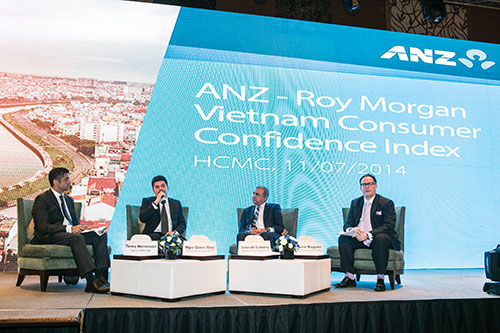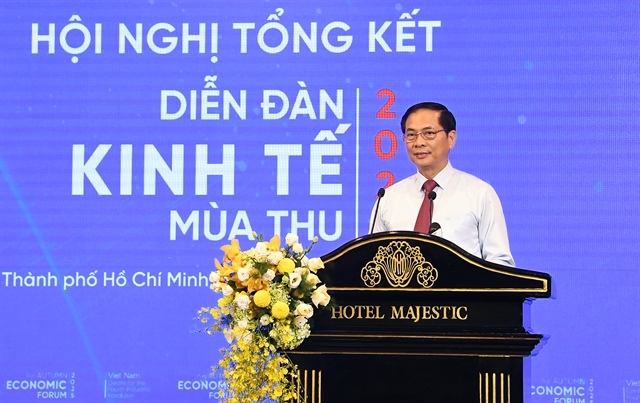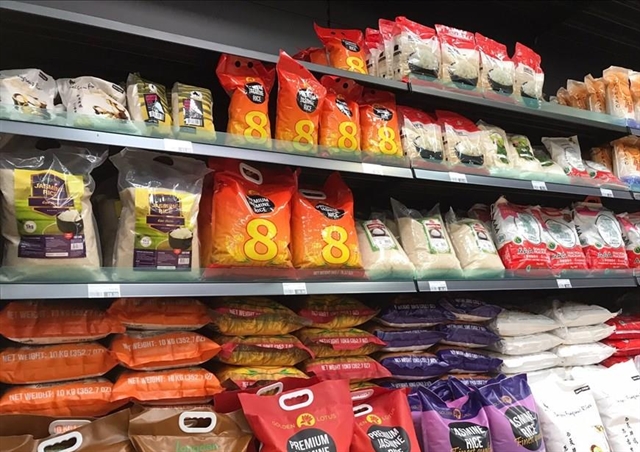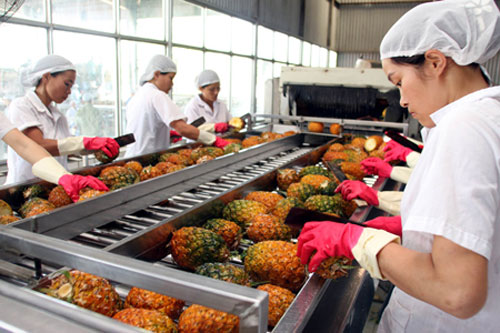New index to track consumer trends
New index to track consumer trends
ANZ and Roy Morgan Research last week introduced their first monthly Vietnam Consumer Confidence Index as a gauge for policy makers, and companies to monitor the growing importance of consumers in the economy. Glenn B. Maguire, chief economist of ANZ in Asia-Pacific provides an insight into the rise of the Vietnamese consumer.

With a population of nearly 90 million - more than Australia, New Zealand and the United Kingdom combined – Vietnam is the world’s 14th most populous economy. In our recent Insight Report, Caged Tiger, we identified Vietnam as one of the Asian economies we expected to transit through the middle income trap and be part of the ten-largest Asian economies that will dominate the global economy mid-century.
Vietnam is generously endowed with the structural gifts of a large and youthful population and as foreign direct investment increasingly relocates factory production to Vietnam, both the capital and technological inputs to Vietnam’s growth are likely to also grow strongly for decades to come with technology and skills transfers aligned to support ongoing robust productivity growth.
Given Vietnam’s relatively large and youthful population, if current per-capita income growth were to continue, the Vietnamese consumer will become an important driver of not just domestic, but also regional and global consumption trends.
Vietnam - home to Asia’s fastest growing consumer class!
With headline gross domestic product (GDP) growth having averaged over 6.5 per cent since the year 2000, and average monthly earnings having grown by nearly 10 per cent per annum in recent years, aggregate income formation in Vietnam is very high. The broadest measure of income within the economy is GDP per capita and this has recorded average growth since 1990 of nearly 15 per cent. This is the fastest growth rate of any economy within Asia including China.
The combination of high levels of growth and firm increases in average monthly earnings has seen Vietnam become home to the fastest-growing consuming class in the region. Between 2010 and 2020, the consumer population is likely to have more than tripled from 10 million to 32 million, and to 66 million in 2030. In just fifteen years, Vietnam is likely to display a middle-class similar to that of South Korea and Taiwan today.
For Vietnam, we believe that a genuine discretionary consumption dynamic is occurring at lower levels of income, at around $5 per day. Based on our calculations, Vietnam’s average wages moved sustainably through the $5 per day mark in 2010 and hence the beginning of a broad-based discretionary spending capability within the Vietnamese economy will become more apparent.
As Vietnam’s average monthly earnings are growing at around 10 per cent per annum, coupled with a highly favourable demographic backdrop over coming decades, more and more Vietnamese will enter the labour force for the first time thereby organically contributing to the growth of the “consuming class”. By 2020, average per capita income is likely to have risen from around $1,200 per year to around $3,000 per year. This will put Vietnam firmly in the Asian consuming class.
We estimate over the remainder of this decade, Vietnam will add over 2 million people to the consuming class each year. As a result, demand for everything from homes to cars and everything in between will rise sharply. Given these dynamics, it is important to have accurate measures of consumer sentiment so that corporations and policy makers can gauge likely spending dynamics and the appropriate policy settings to manage that.
Productivity growth underpins the rapid and durable middle-class formation
The productivity adjustment is likely to gain speed in Vietnam in coming years as multinationals shift production platforms into lower labour cost centres such as Vietnam. As of May 20, there were 500 newly-approved foreign direct investment (FDI) projects, while 167 existing projects received additional funding worth $1.8 billion, taking total FDI for the first quarter to $5.5 billion.
As foreign manufacturers build capacity in Vietnam, it is likely that they will deepen the skill set of workers via on-the-job training and education. This technology and skills transfer will be important in boosting productivity and supporting strong nominal income gains in the coming years. This will continue to strengthen domestic demand and push increasingly larger cohorts of the population into a genuine “consuming class.”
Vietnam is part of a rising Asian middle class
A truly global middle class is emerging that will be dominated by China, India and Indonesia. Over the next fifteen years the of the global middle class will more than double from around 2 billion today to nearly 5 billion by 2030. By 2030, Asia will host 64 per cent of the global middle class and account for over 40 per cent of global middle-class consumption.
In Asia, the balance is shifting from the industrialised regions like Japan, South Korea, Hong Kong, and the wealthy oil-producing countries in the Middle East towards emerging markets. Middle-class consumers in emerging Asian markets have huge potential and increasing influence, and they also have fundamental differences from their developed market counterparts and more importantly, from their developing Asian economy counterparts.
First, the emerging middle-class consumers differ in their demands, preferences and habits. In Vietnam, this can result in two differing types of behaviour. Some of the older consuming class consumers are likely to remain thrifty, even at higher levels of disposable income, as memories of hardship endured in the past remain fresh. On the other hand, .
Second, the middle class in Asian emerging markets is made up of a much younger population than that of developed markets. In Vietnam, 56 percent of the population is aged below 30, and the average age is just 25. These young middle-class consumers are likely to be particularly sensitive about brand trends and what marketers refer to as the “user experience”. Vietnam’s young and tech-savvy population has, for instance, seen it emerge as one of Apple’s hottest markets. In 2014, Apple’s sales growth tripled in Vietnam in the first three months of the year.
Vietnamese do not identify as “middle class” despite rapidly moving into this cohort
One of the most interesting dynamics in Vietnam is that perceptions of social class still remain very low. Whereas the majority of Indonesian’s already identify as “middle class” despite having per-capita income levels that are around 40 per cent higher than Vietnam, the majority of Vietnamese still perceive themselves as being below middle class. Indeed of the economies we cover in Asia, Vietnam has the lowest proportion of the population who identify as middle class.
Given this identification problem, the propensity of the Vietnamese consumer to spend income gains may actually be higher than subjective class perceptions would suggest. Certainly the demographic endowment of the Vietnamese economy would suggest that the bulk of the population is likely to be in cohorts that the life-cycle hypothesis would align with higher levels of consumption relative to savings.
A particularly interesting dynamic, is that though the proportion of Vietnamese who identify themselves as “middle class” is quite low, there can be little doubt that many Vietnamese would expect to be moving into middle class and upper class cohorts in coming years. This point reinforces our view that discretionary spending dynamics are kicking in at lower levels in Vietnam than have been seen in some other emerging economies.
The interesting challenge will be for domestically-based Vietnamese companies and how they realign their growth models to growing domestic demand. Many Vietnamese companies have been more closely tied to their sales in developed markets than to their sales in domestic markets. As domestic consumer spending grows in coming years, not only will domestic companies but also developed market multinationals find superior growth prospects on offer if they choose to engage with the domestic Vietnamese market more fully.
vir





















